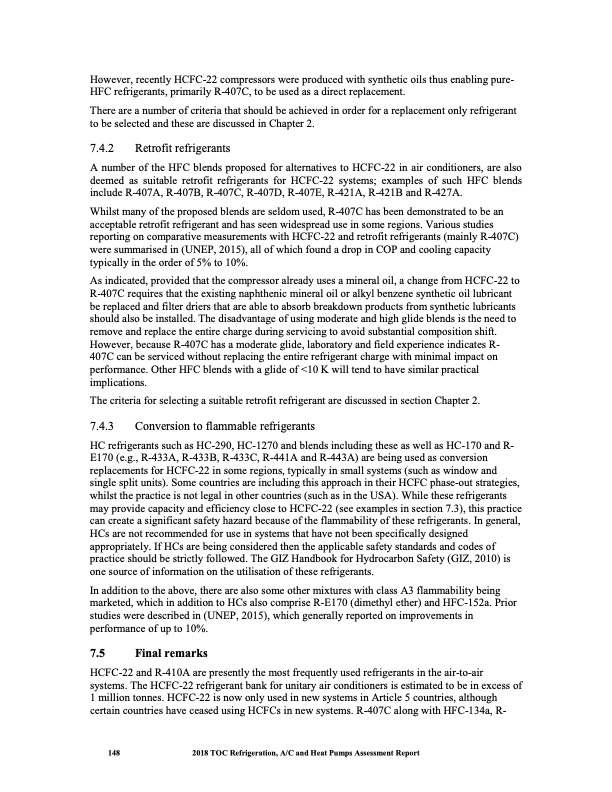
PDF Publication Title:
Text from PDF Page: 161
However, recently HCFC-22 compressors were produced with synthetic oils thus enabling pure- HFC refrigerants, primarily R-407C, to be used as a direct replacement. There are a number of criteria that should be achieved in order for a replacement only refrigerant to be selected and these are discussed in Chapter 2. 7.4.2 Retrofit refrigerants A number of the HFC blends proposed for alternatives to HCFC-22 in air conditioners, are also deemed as suitable retrofit refrigerants for HCFC-22 systems; examples of such HFC blends include R-407A, R-407B, R-407C, R-407D, R-407E, R-421A, R-421B and R-427A. Whilst many of the proposed blends are seldom used, R-407C has been demonstrated to be an acceptable retrofit refrigerant and has seen widespread use in some regions. Various studies reporting on comparative measurements with HCFC-22 and retrofit refrigerants (mainly R-407C) were summarised in (UNEP, 2015), all of which found a drop in COP and cooling capacity typically in the order of 5% to 10%. As indicated, provided that the compressor already uses a mineral oil, a change from HCFC-22 to R-407C requires that the existing naphthenic mineral oil or alkyl benzene synthetic oil lubricant be replaced and filter driers that are able to absorb breakdown products from synthetic lubricants should also be installed. The disadvantage of using moderate and high glide blends is the need to remove and replace the entire charge during servicing to avoid substantial composition shift. However, because R-407C has a moderate glide, laboratory and field experience indicates R- 407C can be serviced without replacing the entire refrigerant charge with minimal impact on performance. Other HFC blends with a glide of <10 K will tend to have similar practical implications. The criteria for selecting a suitable retrofit refrigerant are discussed in section Chapter 2. 7.4.3 Conversion to flammable refrigerants HC refrigerants such as HC-290, HC-1270 and blends including these as well as HC-170 and R- E170 (e.g., R-433A, R-433B, R-433C, R-441A and R-443A) are being used as conversion replacements for HCFC-22 in some regions, typically in small systems (such as window and single split units). Some countries are including this approach in their HCFC phase-out strategies, whilst the practice is not legal in other countries (such as in the USA). While these refrigerants may provide capacity and efficiency close to HCFC-22 (see examples in section 7.3), this practice can create a significant safety hazard because of the flammability of these refrigerants. In general, HCs are not recommended for use in systems that have not been specifically designed appropriately. If HCs are being considered then the applicable safety standards and codes of practice should be strictly followed. The GIZ Handbook for Hydrocarbon Safety (GIZ, 2010) is one source of information on the utilisation of these refrigerants. In addition to the above, there are also some other mixtures with class A3 flammability being marketed, which in addition to HCs also comprise R-E170 (dimethyl ether) and HFC-152a. Prior studies were described in (UNEP, 2015), which generally reported on improvements in performance of up to 10%. 7.5 Final remarks HCFC-22 and R-410A are presently the most frequently used refrigerants in the air-to-air systems. The HCFC-22 refrigerant bank for unitary air conditioners is estimated to be in excess of 1 million tonnes. HCFC-22 is now only used in new systems in Article 5 countries, although certain countries have ceased using HCFCs in new systems. R-407C along with HFC-134a, R- 148 2018 TOC Refrigeration, A/C and Heat Pumps Assessment ReportPDF Image | Heat Pumps Technical Options

PDF Search Title:
Heat Pumps Technical OptionsOriginal File Name Searched:
RTOC-assessment-report-2018_0.pdfDIY PDF Search: Google It | Yahoo | Bing
CO2 Organic Rankine Cycle Experimenter Platform The supercritical CO2 phase change system is both a heat pump and organic rankine cycle which can be used for those purposes and as a supercritical extractor for advanced subcritical and supercritical extraction technology. Uses include producing nanoparticles, precious metal CO2 extraction, lithium battery recycling, and other applications... More Info
Heat Pumps CO2 ORC Heat Pump System Platform More Info
| CONTACT TEL: 608-238-6001 Email: greg@infinityturbine.com | RSS | AMP |